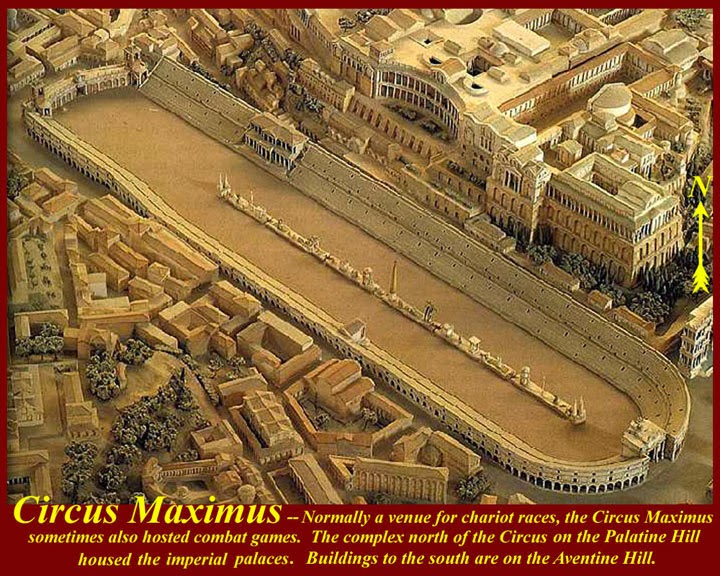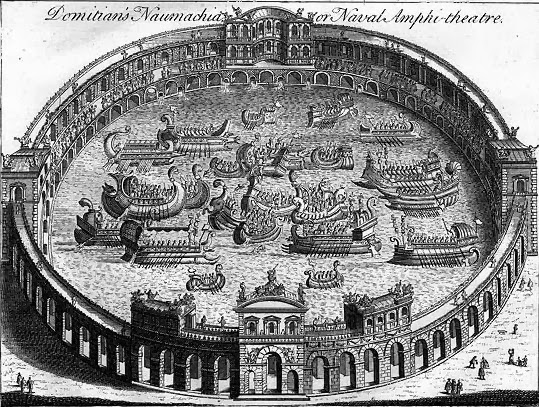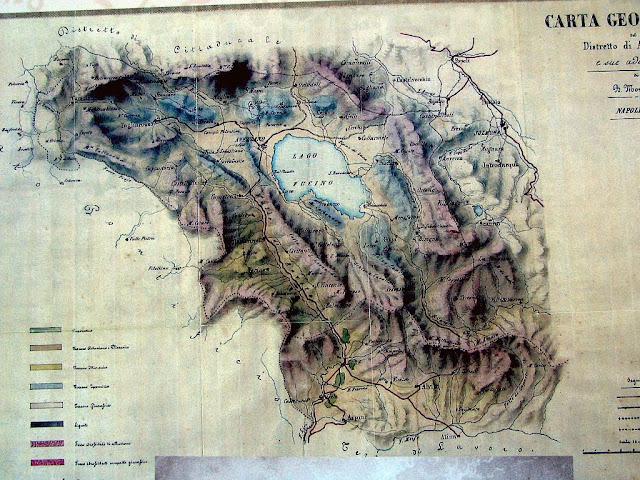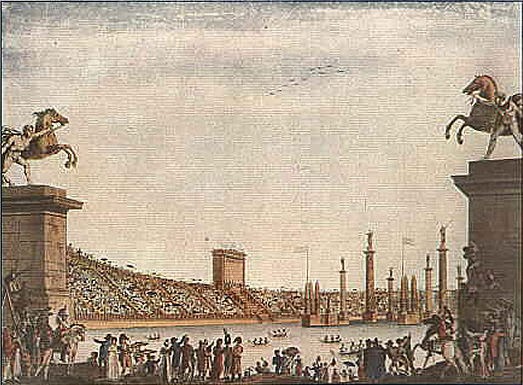Naumachia

Although the Colosseum served for many centuries as a center of hideous spectacle and barbarous cruelty, at the time of its construction,
A naumachia held at the Colosseum. Illustration by G. Nispi-Landi, 1913
Romans saw it as part of the rightful restoration into public hands of land which had been illegally expropriated by the despised Emperor Nero.
At the very heart of Rome, from the Palatine to the Esquiline, Nero had built a large private estate, the symbolism of which had been plain to everyone.
Nero had even blocked the people's access to the Sacre Via, Rome's most sacred thoroughfare and,
L- The_Arch_of_Titus_on_the_Via_Sacra,_Rome
in a city which traditionally frowned upon ostentation in private dwellings even for the rich, built himself a huge and magnificent palace which became known as the Domus Aurea or "Golden House".
An 18th Century print by J Blundell shows the scale of Nero's Golden Palace, which, if completed, would have spanned a third of the city of Rome
Nero-Golden-House-Engraving
On a ridge on the northern face of the Palatine, Nero had erected for himself a colossal 36 metre high bronze statue and in the middle of the palace grounds was a large artificial lake. After Nero's eventual disgrace and death, his successors competed with one another to break up his estate and to replace it with structures of public utility.
To this end, Emperor Vespasian ushered in an era of long term peace and prosperity, and undertook new public building projects, filled in the lake and built the Amphitheatrum Flavium.
L -Vespasian planning the colosseum
He also moved closer to it the Colossus of Nero which he changed to represent to the god of the Sun.


It is this combination statue and amphitheater which much later led to the site being known as the famous Flavian Amphitheater,
(the
Colosseum), which still stands today.
L- Colosseum aerial view
Considering the watery origins of the site, it seems somehow appropriate that some of the earliest spectacles held there had an aquatic theme.
Following precedents set by Julius Caesar and
Augustus, the amphitheater was used as a venue for naumachia, mock sea battles
which were designed to thrill and divert the masses.
Then scale replicas of naval vessels were floated on
the water and manned with presumably very reluctant crews of prisoners who were
forced to battle for their lives.
The
hand-colored Dutch engraving (1663) from the Netherlands Maritime
Museum (top) is based upon an etching by Étienne du Pérac that was
commissioned by the Veronese scholar Onofrio Panvinio for his book De
Ludis. Based upon measurements and details provided by the author, the
copper plate was etched between 1565-1566 and is almost identical to one
du Pérac later produced for a catalog of engravings by Antonio Lafréry
on ancient Rome. This book was published in 1600, a second edition of
which is in the collection of the Canadian Centre for Architecture, from
which the engraving above has been taken.
The exhibitions were normally reenactment of famous
naval engagements between two fleets such as the Battle of Actium
("Augustus" vs. "Mark Anthony"), the Battle of Salamina
("Greeks" vs. "Persians") etc.
Battle of Actium
Clemency
was sometimes granted to the victors of these battles but, as with other
gladiatorial events, this apparently happened very rarely. They usually
involved a large number of ships and thousands of combatants. These shows - which were apparently held only in the city of Rome - were extremely expensive, because the ships had to be complete in all their details and maneuvered like real ships in battle.
 The
Romans called these shows navalia proelia (naval battles), but they are
commonly known by the equivalent Greek term naumachia, which came to
indicate at the same time the show and the basin built for it.
The
Romans called these shows navalia proelia (naval battles), but they are
commonly known by the equivalent Greek term naumachia, which came to
indicate at the same time the show and the basin built for it.
The naumachia often wanted to reproduce famous historical battles, like the Greeks winning at Salamina against the Persians, or the Corcyreans destroying the Corinthian fleet.
R- Battle of Salamina
The shows must have been imposing: in one naumachia a
fortress was built in the middle of the basin so that the "Athenians"
could land and take the "Syracusan" stronghold.
The
combatants in these sea-fights, called Naumachiarii,
were usually
captives or criminals condemned to death who fought as in gladiatorial combats,
until one party was killed, unless preserved by the clemency of the emperor.
Sometimes there were troupes, like in a historical pageant, and sometimes real
sailors and soldiers.The ships engaged in the sea-fights were divided into two parties, called respectively by the names of two different maritime nations, as Tyrians and Egyptians, Rhodians and Sicilians, Persians and Athenians, Corcyraeans and Corinthians, Athenians and Syracusans.
These sea-fights were exhibited with the same magnificence and lavish expenditure of human life as characterized the gladiatorial combats and other public games of the Romans.
Martial tells us that in the Colosseum naumachiae were staged in the first years after the inauguration, but modern archaeologists (Lugli, The Flavian Amphitheatre) state that they were later abandoned, because "a great deal of preparation was necessary to make the arena watertight to a sufficient depth (about 5' or 1.5 m) to float the ship". R-Martialis
One can wonder how the openings could have been closed in order to flood the Colosseum, and this led some archaeologist to think that the underground of the arena was excavated only some years after the inauguration, under Domitian.
When Julius Caesar returned to Rome in 46 BC, among his triumphs was the first naumachia or mock sea battle (although the life-and-death struggle certainly was real enough to those who were forced to participate).
The first naumachia was financed by Julius Caesar in Rome in 46 BC to celebrate his triumph in Egypt, on occasion of his quadruple triumph. After having a basin dug near the Tiber, capable of holding actual biremes, triremes and quinqueremes, he made 2000 combatants and 4000 rowers, all prisoners of war, fight.
It took place on a water-filled basin constructed in the Campus Martius, a low-lying area in a bend of the river Tiber. There, ships of two, three, and even four banks of oars representing the Tyrian and Egyptian fleets were set afloat, all prisoners of war or condemned to death.
Such was the novelty of the spectacle that people thronged the streets and camped along the roads to see it, many being killed in the crush to witness the death of others. The basin soon was filled in, however, either because Caesar intended to build a temple to Mars on the site or, more likely, by vote of the Senate because of the risk of epidemic from stagnant water when the Tiber flooded.
L-Emperor Augustus
In 2 BC on the occasion of the inauguration of the Temple of Mars Ultor ("Mars the Avenger"), Augustus gave a naumachia based on Caesar's model.
R- Augustus naumachia
Augustus also dug a lake (stagnum) near the Tiber for the same purpose, and planted around it a grove of trees (nemus).
L- lago-di-nemi
This
naumachia was the first permanent one; it continued to be used after others had
been made, and was subsequently called the “vetus naumachia.
the-roman-antiquities-t-1-plate-xii-aqua-alsietina-1756-1
It was supplied with water from a new aqueduct (Aqua Alsietina) which, because the water quality was poor, also irrigated a surrounding park or grove.
 In the
middle of this artificial lake was an island connected by a bridge that was
constructed in part from a single wooden beam one-hundred and twenty feet in
length, the largest tree ever seen in Rome and so impressive that it later was
displayed by Tiberius.
In the
middle of this artificial lake was an island connected by a bridge that was
constructed in part from a single wooden beam one-hundred and twenty feet in
length, the largest tree ever seen in Rome and so impressive that it later was
displayed by Tiberius. The expanse of water was almost as long as the Circus Maximus and two-and-a-half times wider, broad enough to hold thirty triremes and biremes representing the Persian and Athenian fleets at Salamis, as well as a number of smaller craft. Aside from the rowers, three thousand men were said to have fought.
As cited in Res Gestæ (§ 23), he created a basin on the right bank of the Tiber where 3000 men, not counting rowers, fought in 30 vessels with rams and a number of smaller boats. It was held in Rome, in a temporary basin excavated in the Campus Martis, and it recreated a fake battle between Egyptians and Phoenicians.
The Romans enjoyed the show immensely, therefore Augustus organized more naval battles in the Septa, a monumental complex with an open space of 300 x 120 metres, surrounded by porticoes and decorated with works of art from all the conquered countries.
It was obvious that Augustus would like to celebrate the Roman navy, because his supremacy depended upon the victory in a naval battle at Actium, where the admiral was his son in law Agrippa.
For the first time since Gaius Duilius, who had won the naval battles against Carthage, an admiral was more celebrated than a general of the army.
In Rome, Augustus and Domitian had basins excavated only for the naumachia. Augustus' basin measured 598 by 393 yards, and an aqueduct 22,000 paces long was constructed in order to bring the water from the lake today called Martignano, near the lake of Bracciano.
L- Emperor Domitian
Thirty ships and three thousand men participated in the inauguration of Augustus' naumachia, that was still in use at the time of Nero and Titus.
Later Domitian built another naumachia, whose exact location is still a mystery.
R- Another naumachia this time held at a venue built by Emperor Domitian. Several permanent naumachia venues were built in Rome over the centuries. Sometimes the waters were allowed to stagnate becoming a source of malaria within the city.
In AD 57, Nero constructed his own naumachia, a wooden amphitheater in the Campus Martius. Covered with an awning dyed azure to mimic the heavens and spangled with stars, the arena was filled with seawater stocked with fish and other marine creatures.
There was a battle between Persians and Athenians, after which the water immediately was drained and another contest presented between forces on land (Dio, LXI.9.5). Dio also speaks of a spectacle in AD 64 (the year that Nero's fire destroyed his amphitheater) involving a beast hunt followed by a sea fight, then a gladiatorial combat, and finally, the place being flooded again, a public banquet, but the two episodes may have been the same.
The
most elaborate naumachia was sponsored by Claudius in AD 52 to celebrate the
impending completion of an emissary to drain Lake Fucinus in the Apennine
Mountains.
"Like
an open sea," the lake had no surface outlet and was subject to seasonal
inundations so pronounced that marshy land around the shore became dry enough
to till; indeed, the level of the lake has been calculated to have fluctuated
as much as forty feet.
Julius
Caesar had intended to drain the Fucine Lake (or at least control its level)
but was thwarted by the difficulty of the task.
Augustus,
in spite of requests from inhabitants around the shore, refused to intervene.
It was Claudius, as much for glory as for gain (some had agreed to drain the
lake at their own expense if they could have the land that was reclaimed), who
completed the project.
The
greatest naumachia of all time was the naval engagement staged by Claudius. As
Augustus' lake was too small, the mad emperor decided to use the Fucine Lake
(now called the Lago di Fucino) some sixty miles to the east of Rome. This lake
had no natural outlet and in the spring it often flooded many miles of
surrounding county.
Lake_Fucino_Map_
To overcome this trouble, a tunnel three and a half miles long had been cut through solid rock from the lake to the Litis River to carry off the surplus water. This job had taken thirty thousand men eleven years to finish. For the dedication of the opening of this tunnel, Claudius decided to stage a fight between two navies on the lake. The galleys previously used in such engagements had been small craft with only one bank of oars.
For
this fight, there were to be twenty-four triremes (three banks of oars), all
regulation ocean-going warships—and twenty-six bi-remes (double bank). This
armada was divided into two fleets of twenty-five ships each and manned by
nineteen hundred criminals under the command of two famous gladiators.
One
fleet was to represent the Rho-dians and the other the Sicilians and both
groups wore the appropriate costumes... A big tent had even been put up to care
for the wounded after the battle—after all, prisoners were scarce and the
survivors could always be used again in other spectacles. As matters turned out,
the tent served another purpose. Fifteen women in the crowd gave birth during
the fight and had to be cared for in the tent. It is an interesting example of
the mob's passion for these fights that women in advanced pregnancy traveled
sixty miles from Rome so as not to miss the naumachia.
In
Nero's naumachia there were sea-monsters swimming about in the artificial lake,
and Claudius had a silver Triton placed in the middle of the lake Fucinus, who
was made by machinery to give the signal for attack with a trumpet Troops
of Nereids were also represented swimming about.
In the sea-fight exhibited by
Titus there were 3000 men engaged, and in that exhibited by Domitian the ships
were almost equal in number to two real fleets. In the battle on the lake
Fucinus there were 19,000 combatants and fifty ships on each side.
According to this Wikipedia article, Trajan's naumachia basin was discovered in the 18th century on the grounds of the Vatican City. It had bleachers and the surface was about one sixth the size of the Augustan naumachia. In the absence of any texts, it has to be assumed that it was only used at the time of Trajan.(see Naumachia Vaticana).
R-Emperor Phillipus the Arab
There
possibly was one last recorded naumachia, the Naumachia Philippi. Aurelius Victor
relates that Philip the Arab constructed a reservoir on the far side of the
Tiber to alleviate a chronic shortage of water there. When Victor wrote a
century-and-a-half later, it may have served that function. But it also could
have been a restoration of the naumachia Augusti and used for the same purpose,
when, in AD 248, Philip commemorated the millennium of Rome's founding.
RELATED PHOTOS:
A modern naumachia held in the Civic Arena of Milan in the presence of Emperor Napoleon, 1807.
A century later, Milan's Civic Arena once again filled with water.
Inside the Colosseum
The Colosseum today
*(taken from many sources)






























.jpg)








Hi, Better--
ReplyDeleteHaving somewhat of a grasp of Roman history, as far as the progression of the Caesars and what happened during the reign of each, such facts as this elaborate system to accommodate the reenactment of sea battles is something about which I didn't know any more than I did about the Roman statues being painted. Thanks again.
~Manfred
You're welcome, M...
DeleteKeep alive your
sense of wonder :)